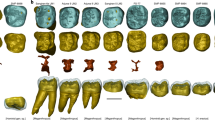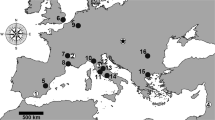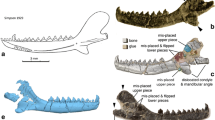Abstract
Today and in the Tertiary, the geographical distribution of castorids is limited throughout all of the northern continents. Fossils of the Castoridae genus Steneofiber are abundant in many localities of Eurasia from the late Oligocene to Pliocene period. Recently, Steneofiber fossils were discovered in two localities of northern Thailand, Mae Moh and Chiang Muan coal mines, in layers of late middle Miocene age. These discoveries represent the first records of castorids from Southeast Asia and correspond to their southernmost known range. The focus of this study is to describe this new Thai species of Steneofiber and to define its wear stages from the molar occlusal surfaces by using micro-CT scan analysis. The CT scan technique permits the analysis of the virtual occlusal surface changes from wear, allowing easier comparison to related species of Steneofiber cheek teeth without destroying the teeth. The new species, Steneofiber siamensis n. sp., can be distinguished from the other species of Steneofiber by several distinct characters, longer mesostriid on p4, presence of premesostria and metastria on P4, which are smaller than most of the other known species. The occurrence of this new castorid also supports a subtropical to tropical paleoclimate for these two localities of northern Thailand.






Similar content being viewed by others
References
Bendukidze OG, Bruijn H, Hoek O, vanden LW (2009) A revision of late oligocene associations of small mammals from the Aral Formation (Kazakhstan) in the National Museum of Georgia, Tbilissi. Palaeodiversity 2:343–377
Billups K, Schrag DP (2003) Application of benthic foraminiferal Mg/Ca ratios to questions of Cenozoic climate change. Earth Planet Sci Lett 209:181–195. doi:10.1016/S0012-821X(03)00067-0
Bruch AA, Uhl D, Mosbrügger V (2007) Miocene climate in Europe—patterns and evolution: a first synthesis of NECLIME. Palaeogeogr Palaeoclimatol Palaeoecol 253:491–512. doi:10.1016/j.palaeo.2007.03.030
Bruijn H, Mayda S, Hoek O, Vanden L, Kaya T, Saraç G (2006) Small mammals from the Early Miocene of Sabuncubeli (Manisa, S.W. Anatolia, Turkey). Beitr Paläont 30:57–87
Chaimanee Y, Jolly D, Benammi M, Tafforeau P, Duzer D, Moussa I, Jaeger JJ (2003) A middle Miocene hominoid from Thailand and orangutan origins. Nature 422:61–65. doi:10.1038/nature01449
Coster P, Benammi M, Chaimanee Y, Yamee C, Chavasseau O, Emonet EG, Jaeger JJ (2009) A complete magnetic–polarity stratigraphy of the Miocene continental deposits of Mae Moh Basin, northern Thailand, and a reassessment of the age of hominoid-bearing localities in northern Thailand. Geol Soc Am Bull 122:1180–1191. doi:10.1130/B26568.1
Daxner-Höck G, Bernor RL (2009) The early Vallesian vertebrates of Atzelsdorf (Late Miocene, Austria) 8. Anchitherium, Suidae and Castoridae (Mammalia). Ann Naturhist Mus Wien 111A:557–584
Geoffroy Saint-Hilaire EF (1833) Considérations sur des ossements fossiles la plupart inconnus, trouvés et observés dans les bassins de l’Auvergne. Rev Encycl 59:76–95
Ginsburg L (1968) L’évolution de climat au secours du Miocène en France. Bull Assoc Nat Orléan 41:3–13
Ginsburg L (1971) Sur l’évolution des Steneofiber (Mammalia, Rodentia) en France. C R Acad Sci Paris Ser D 273:2159–2161
Henrot AJ, François L, Favre E, Butzin M, Ouberdous M, Munhoven G (2010) Effects of CO2, continental distribution, topography and vegetation changes on the climate at the Middle Miocene: a model study. Clim Past Discuss 6:489–535. doi:10.5194/cpd-6-489-2010
Hugueney M (1975) Les Castoridae (Mammalia, Rodentia) dans l’Oligocène d’Europe. Col Int C N R S 218:791–804
Hugueney M (1999) Family Castoridae. In: Rössner GE, Heissig K (eds) The Miocene land mammals of Europe. Verlag Friedrich Pfeil, Munich
Hugueney M, Escuillié F (1995) K-strategy and adaptive specialization in Steneofiber from Montaigu-le-Blin (dept. Allier, France; Lower Miocene, MN 2a ± 23 Ma): first evidence of fossil life-history strategies in castorid rodents. Palaeogeogr Palaeoclimatol Palaeoecol 113:217–225. doi:10.1016/0031-0182(95)00050-V
Hugueney M, Escuillié F (1996) Fossil evidence for the origin of behavioral strategies in early Miocene Castoridae, and their role in the evolution of the family. Paleobiology 22:507–513
Kato T, Otsuka H (1995) Discovery of the Oligo-Miocene rodents from West Japan and their geological and paleontological significance. Vertebr PalAsiat 33:315–329
Koenigswald W, Mörs T (2001) The enamel microstructure of Anchitheriomys (Rodentia, Mammalia) in comparison with that of other beavers and of porcupines. Paläontol Z 74:601–612. doi:10.1007/BF02988167
Korth WW (1994) The tertiary record of rodents in North America. Plenum Press, New York, p 319
Korth WW (1996) A new genus of beaver (Mammalia: Castoridae: Rodentia) from the Arikareean (Oligocene) of Montana and its bearing on castorid phylogeny. Ann Carnegie Mus 65:167–179
Korth WW (2001) Comments on the systematic and classification of the beaver. J Mamm Evol 8:279–296. doi:10.1023/A:1014468732231
Lauriat-Rage A, Brebion P, Cahuzac B, Chaix C, Ducasse O, Ginsburg L, Janin MC, Lozouet P, Margerel JP, Nascimento A, Pais J, Poignant A, Pouyet S, Roman J (1993) Paleontological data about the climatic trends from Chattian to present along the Northeastern Atlantic frontage. Proc 1st R C A N S Congr, Lisboa, pp 167–179
Lopatin AV (2003) The revision of the Early Miocene beavers (Castoridae, Rodentia, Mammalia) from the North Aral Region. Russian J Theriol 2(1):15–25
Majewski W, Bohaty SM (2009) Surface-water cooling and salinity decrease during the Middle Miocene climate transition at Southern Ocean ODP Site 747 (Kerguelen Plateau). Marine Micropaleontol 74:1–14. doi:10.1016/j.marmicro.2009.10.002
Martin T (1993) Early rodent incisor enamel evolution: phylogenetic implications. J Mamm Evol 1:227–253. doi:10.1007/BF01041665
Mörs T, Stefen C (2010) The castorid Steneofiber from NW Germany and its implications for the taxonomy of Miocene beavers. Acta Palaeontol Pol 55:189–198. doi:10.4202/app.2009.0013
Pomel A (1847) Note sur des animaux fossiles découverts dans le département de l’Allier (addition au Mémoire sur la géologie paléontologie etc). Bull Soc Géol Fr 4:378–385
Sepulchre P, Jolly D, Chaimanee Y, Jaeger JJ (2009) Mid-Tertiary palaeoenvironments in Thailand: pollen evidences. Clim Past Discuss 5:709–734. doi:10.5194/cpd-5-709-2009
Stefen C (1997) Steneofiber eseri (Castoridae, Mammalia) von der Westtangente bei Ulm im Vergleich zu anderen Biberpopulationen. Stuttg Beitr Natkunde Ser B 255:1–73
Stefen C (2005) Description of the cranial morphology of the early miocene beaver Steneofiber castorinus. Neues Jahrb Mineral Paläontol Monatsh 10:577–596
Stefen C (2009a) The beaver (Mammalia: Castoridae) from Sandelzhausen (SW−Germany). Paläontol Z 83:183–186. doi:10.1007/s12542-009-0005-9
Stefen C (2009b) The European Tertiary beaver Chalicomys jaegeri (Rodentia: Castoridae) revisited. Kaupia 16:161–175
Stefen C (2010) Morphometric considerations of the teeth of the Palaeocastorine beavers Capacikala, Palaeocastor and “Capatanka”. Palaeontol Electron 13:1–34. Available from: http://palaeo-electronica.org/2010_1/191/index.html. Accessed on: March 2010
Stehlin HG, Schaub S (1950) Die Trigonodontie der simplidentaten Nager. Schweiz Palaeont Abh 65:5–385
Stirton RA (1935) A review of tertiary beavers. Univ Calif Publ Geol Sci 23:391–458
Sulimski A (1964) Pliocene Lagomorpha and Rodentia from Wéze I Poland. Acta Palaeontol Pol 9:150–279
Ünay E (1977) Çatakbağyaka Üst Miyosen Steneofiber’leri (Rodentia, Mammalia). Bull Geol Soc Turk 20:69–72
Wu W, Meng J, Ye J, Ni X (2004) Propalaeocastor (Rodentia, Mammalia) from the Early Oligocene of Burqin Basin, Xinjiang. Am Mus Novit 3461:1–16. doi:10.1206/0003-0082(2004)461<0001:PRMFTE>2.0.CO;2
Xu X (1994) Evolution of Chinese Castoridae. In: Tomida Y, Li CK and Setoguchi T (eds) Rodent and lagomorph families of Asian origin and diversification. National Science Museum Monographs, n°8, Tokyo, pp 77–98
Acknowledgments
We would like to thank Edouard-Georges Emonet and Thibaut Bienvenu for their help on the micro-CT scan analysis, and to Pauline Coster for the information relative to magnetostratigraphic results in these two localities. We are obligated to Christine Argot and Pascal Tassy for giving us facilities and help to visit and compare the materials of Steneofiber from Saint-Gérand-Le-Puy at the Muséum National d’Histoire Naturelle collections of Paris, and Mana Rugbumrung from Department of Mineral Resources, Bangkok for his assistance in the field. Financial support came from the Department of Mineral Resources, Bangkok, the University of Poitiers, the CNRS “Eclipse2” program and the ANR-05-BLAN-0235 and ANR-09-BLAN-0238-02-EVAH programs. We thank also Electricity Generating Authority Thailand for giving us access to Mae Moh mine and in providing logistic and technical assistance. Finally, we are grateful to Linda Ducrocq for improving the English version, and associate editor and all reviewers who greatly commented on this manuscript.
Author information
Authors and Affiliations
Corresponding author
Additional information
Communicated by: Robert Asher
Electronic supplementary material
Below is the link to the electronic supplementary material.
Table 1
Dental measurements, length (L), width (W), crown height (H), and crown height index ratio (H/L), of Steneofiber siamensis n. sp. teeth (in millimeters; XLS 24 kb)
Rights and permissions
About this article
Cite this article
Suraprasit, K., Chaimanee, Y., Martin, T. et al. First Castorid (Mammalia, Rodentia) from the Middle Miocene of Southeast Asia. Naturwissenschaften 98, 315–328 (2011). https://doi.org/10.1007/s00114-011-0769-0
Received:
Revised:
Accepted:
Published:
Issue Date:
DOI: https://doi.org/10.1007/s00114-011-0769-0




